“Overly talky” versus a book that had Chris Claremont writing for it.
So back in Ye Olden Dayes of this blog, when I wrote about specific comics, all I had to do was dip into the Vast Mikester Comic Archives and pull out a copy of the book I wanted to discuss. “Ah, yes, fetch me that copy of Superman’s Girlfriend Lois Lane #106, would you Jeeves, that’s a good chap,” as I reclined into my Marc Newson Lockheed Lounge Chair, quill in hand, ready to pen the latest enthralling installment of Progressive Fancypants dot com.
Well, that changed when all thoughts of fancypantsness went out the window as I opened up my own comic book store, and the Vast Mikester Comic Archives became The Dismal Dregs once I gave over my personal stock to shop stock. Now when I want to discuss a particular book, it’s either one that I came across at my store, one I can pull images from DCUniverseInfinite.com, or I can bum pics off a pal, usually Bully.
It’s particularly frustrating when the books I want to discuss are definitely ones I bought off the stands at the time of release, and long since given up to the shop, such as 1985’s Heroes for Hope Starring the X-Men from Marvel Comics:
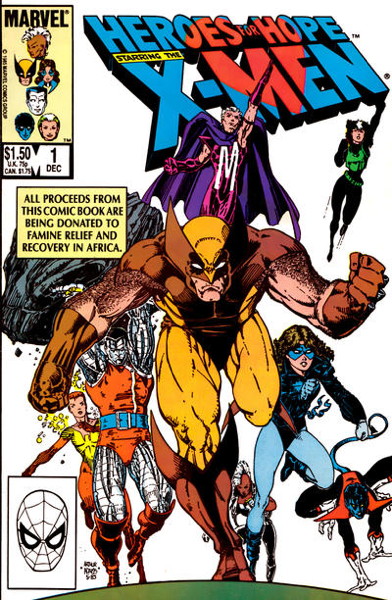
and Heroes Against Hunger from DC Comics:
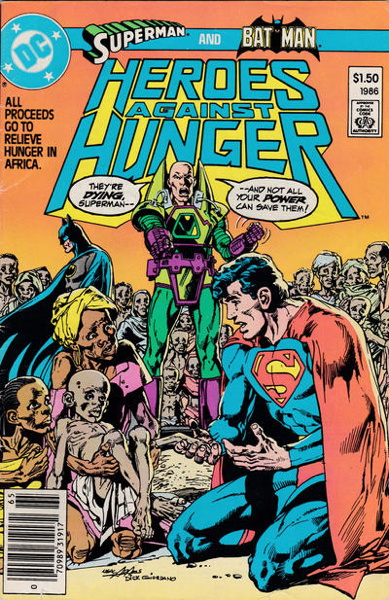
Produced during that time pop culture remembered that Africa was having some problems, these were fundraising comics to aid the fight against starvation. Honestly, I don’t know how much money was raised by these projects, given each had a price tag of $1.50, so the wholesale price was about half that (unless there was a different discount structure in place for these particular books, which is possible), and unless those distributors also donated their share of the profits…well, that wasn’t much per issue going to charity. It’s a little better once you multiply that portion of the cover price by however many copies were sold to retailers (for which I have no info, so I’m gonna make the rough estimate of about 300,000 for the X-Men book, and half that for the DC one), then maybe you’re talking some real money. Maybe not “We Are the World” money, but not nuthin’, either.
I’m sure some enterprising person out there already crunched all those numbers and I’ll hear about it shortly, but that would take some kind of “internet search engine” to locate something like that. I’ll have to ask my man Jeeves to look into it. Anyway, that’s not what I’m here to talk about.
No, what I’m here to talk about is the impact these books had on me, and possibly also on cultural awareness overall (as far as “comic book fandom cultural awareness” goes on something like this). And all this came about because I was processing a collection the other day that had a copy of the Marvel benefit book. That in itself isn’t terribly unusual…copies of this title show up in collections all the time, far more frequently than the DC counterpart, which is why I presumed earlier the vast disparity in printruns.
But whenever I get a copy, I poke through it and marvel (so to speak) at the creative teams they put together for the short vignettes within…usually only two or three pages long by a specific creative team. There is a bare thread of a storyline connecting everything, but the real meat are the small character bits each short provides, as the various X-Men face personal, emotional challenges. Harlan Ellison and Frank Miller presents Wolverine rising above his savage instincts, Chris Claremont and Brian Bolland have Storm confronting her various self-images, Stephen King(!) and Bernie Wrightson have Kitty face off against…well, hunger (there’s more to it than that, didn’t flip through it agin to refresh my memory, but boy that “Good God, let’s eat!” still sticks with me). And then there’s this, which I took an askew shot of at the shop to post onto Twitter:
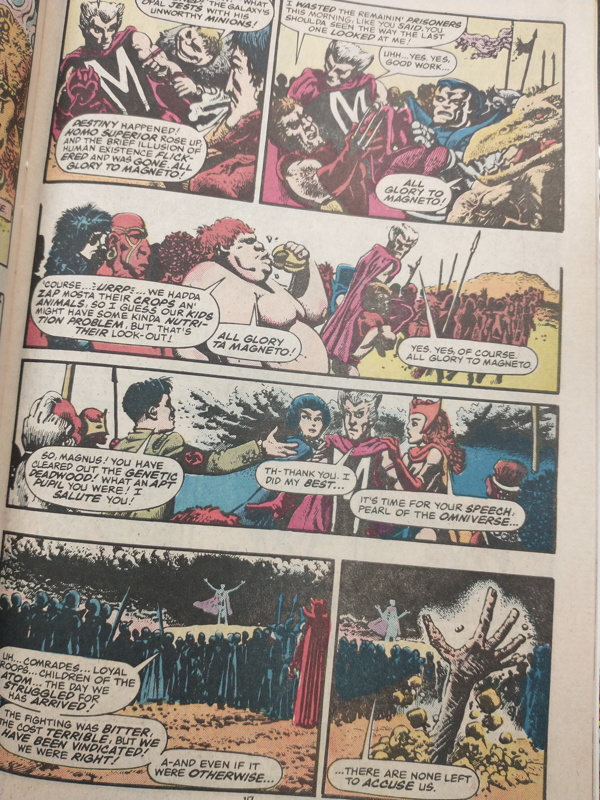
…contrasting Magneto’s Holocaust survivor background with the future he may bring about with his battle for mutant superiority over the common folk. I mean, Hitler shows up on this page to praise Magneto, it ain’t exactly subtle. It’s Alan Moore in a very rare bit of Marvel work (his only new post-UK work for the company, I believe), drawn by the underground comix legend Richard Corben. Not shown (except a bit in the last panel of that page there) are the great rotting corpses that only Corben could create. It may very well be one of my favorite bits of X-Men comics.
Here’s the thing about not having these comics readily accessible in my collection any more. I have to depend on my memories of having read the books. Yes, I said I get the Marvel book in collections all the time, but I’m not spending time to flip through each copy that shows up. It was only the other day where I thought “you know what’s good? this Moore/Corben sequence” and decided to take a picture of it so I could say so on the Twitterers. Many of the images and events of this comic stick in my mind clearly, nearly 40 years after I first saw them. That emaciated Kitty Pryde, Wolverine standing triumphant, Storm in her various guises, a guilt-ridden Magneto. I don’t remember a whole lot else from the comic, but those have been living in my brain a very long time.
Now let’s take the DC book. Similar in structure to the Marvel comic, it’s made up of short 2-3 page sequences each by a different creative team, strung together into a semblance of a story. I have two primary memories of this comic, which I definitely bought and read at the time.
The first memory is of a review I read of it in, well, probably has to be Amazing Heroes. Basically the complained about the inconsistency of the writing, specifically citing that Lex Luthor’s characterization would change from segment to segment. An inherent problem, I suppose, in having this many writing cooks in the kitchen.
The other memory was of Luthor weeping when put face to face with starving people. I mentioned that scene online, and it was Twitter pal BobH to the rescue, snapping a pic of that very moment:
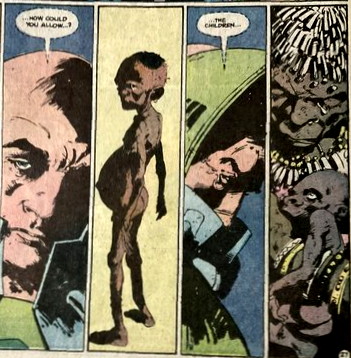
As BobH pointed out, that’s by Barry Windsor-Smith and Catherine Jones, an impressive art team by any measure. He also mentions Bernie Wrightson inked by Mike Kaluta (wow!) and Jose Luis Garcia-Lopez inked by Jerry Ordway (another shot from BobH):
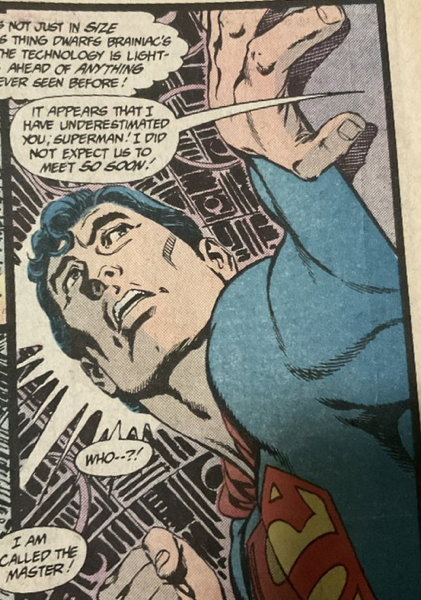
A look at the credits shows lots of other impressive (and weird) combos. I mean, Carmine Infantino and Murphy Anderson! Curt Swan inked by John Byrne! Walt Simonson inked by Steve Leialoha! (That one’s gotta be weird!) C’mon, Kirby is in this! There’s a lot of what should be some spectacular work in here.
I just don’t remember any of it. Nothing from the book stuck, except that one image of Luthor. (Which I liked, by the way…I always preferred the “yes he’s a bad guy but not a complete monster” pre-Crisis Luthor to the nigh-irredeemable post-Crisis Luthor we’d get only a couple of years after this.) Otherwise my mental image of the book was that it was…cluttered and cramped, overly talky and not as visually memorable or striking as the X-Men comic. The DC one even had its own Big Name Horror Writer in Robert Bloch, for a sequence also drawn by Wrightson, and hand-to-God I couldn’t tell you a single thing about it.
Not to say the X-Men book totally ruled and the DC one drooled or anything. The former had a bit by Mike Baron/Steve Rude, a creative team I normally like, which I looked at briefly in the copy I had at the store and gosh darn if I could tell what was going on. And frankly the DC book sounds a lot better than I remember, but I still feel like it does just sound that way, that something in the execution made it a less memorable offering that the Marvel release.
Lot of words to throw at you to essentially say “I remember one book more fondly than the other” but this is just one of those things I go through as an older fan who’s had a lot of comics pass through my hands. Interesting in that both Jim Starlin and Wrightson were involved in creating the storylines for both.
Anyway, I put this here so that I can maybe get some feedback on the books, about what I’m not remembering, about what was outstanding about the DC book that should be remembered as well as those top-flight stories from the Marvel comic. But I have to be honest, it’s gonna be hard to beat that Magneto strip.
EDIT: Everything old is new again! I just reminded myself that I wrote about these books on the site before, because of course I have! Here I am talking about the Marvel one, and here’s DC…more images (and some linkrot) for your perusal!








The only thing I remember about the DC book (assuming that I am remembering correctly) is the weird way that Joe Brozowski (sp?) drew Batman’s cowl, particularly the eyes. I think he was going for a realistic approach (in the pre-Tim Burton days), but it ended up looking like the mask from the 1940s Batman movie serials.
I bought the Marvel book but not the DC. I was much more invested in the X-Men than Batman and Superman, at least until Byrne defected to DC, which I see now is right after this benefit book was published.
I agree with your original post (about the Marvel book) that it’s tacky to use the starvation of millions of people to explore the identity crises of some fictional characters. But if that creates sales, then I suppose it helps. It worked on me.
Stephen King probably did the least tacky work in the Kitty Pryde segment. Transferring starvation unto a character we know and care about might have driven the famine home to comic fans more clearly than Wolverine declaring himself a-man-not-a-beast for the umpteenth time. I definitely remember having a visceral response to the Kitty segment that was different from the rest of the book.
Jim Shooter claims that Heroes for Hope generated in excess of $500,000 in sales and donations for the American Friends Service Committee. That number seems inflated, but what do I know?
Lots of interesting analysis of Heroes for Hope online, including a story from Christopher Priest about Marvel not asking any Black creators to contribute. All in all it seems like a product of its time that was created in good faith and may have helped at least a little.
I’m a DC guy (though these were released during my peak Marvel buying days), and I have Heroes for Hope and not Heroes Against Hunger, for what it’s worth.
Didn’t Marvel really hype that Stephen King conttibuted to this issue? Had he done anything specifically for comics by then?
I always, always mix these up and refer to them as a single comic called Heroes Against Hope. Prefiguring comics’ Dark Age.
FYI, Alan Moore contributed to at least one more book published by Marvel post-Captain Britain. He wrote a paragraph that appeared in the magazine-sized 9/11 charity book Marvel published soon after September 11th.
In addition to the King/Wrightson and Moore/Corben sections, Heroes for Hope has a nicely-drawn Nightcrawler sequence illustrated by Charles Vess. IIRC, the Wolverine pages were penciled by Frank Miller and inked by Bill Sienkiewicz. They looked great.
The first half of Heroes for Hope was much stronger than the second half. The character vignettes all had memorable scenes, but the Africa sequences were pretty blah. I think most of the better artists show up in the first half, too.
As for Heroes Against Hunger… I think there’s a Bill Sienkiewicz pin-up, maybe on the back cover? Not the most memorable DC jam book, in an era full of them.
Weren’t Starlin and Wrightson the Midge and Bob of the comics world and were instrumental in getting these made?
What I remember is Bloch writing the most terrible, hackneyed dialog, like his only superhero exposure was Batman ’66. What’s with the light editing touch?
Bought and read both of these books but darned if I can remember a thing about either one. I wonder, however, if the “secret ingredient” to those comic book images that become so deeply ingrained in our consciousness doesn’t have more to do with age and individual development than anything else. I swear I could feel my neural pathways actually forming when I read Jim Starlin’s Warlock story in Strange Tales and Denny O’Neil and Neal Adams GL/GA run. Those memories have outlasted almost everything else from my early teens.
There books came out riiiiight as I was converting from a Marvel Kid (meaning X-Men and maybe a smidge of others) to a DC-favoring Adolescent. Bought the Marvel off the stands, got the DC like a decade later to see what it was.
The Marvel book is better in the sense that it manages to be the only Marvel product I can think of with a Moore-era Swamp Thing or Sandman vibe, that undercurrent of real horror and the “everything you know is wrong” ethos. I mean Hitler literally backslapping Magneto is super intense for the House of Ideas. Marvelman reprints aside, they just don’t go there, they had Doctor Doom cry over 9/11. (Only DOOM may destroy skyscrapers for a grudge, sob sob)
The DC book on the other hand reads like the last pre-Crisis stuff on hand where DC was juuuuuust dipping it’s toe into making the entire line freakdelic (we killed the Flash and Supergirl, kids! You think we won’t do something crazy!?! Check out this GRANT MORRISON dude).
But it’s not there yet, it’s got much more of a late Bronze Age feel, IIRC. See the last DC Comics Presents featuring the Phantom Zone for an example of what I mean about ultra late pre-Crisis freakiness.
Marvel is Sci-Fi and DC is Fantasy but also deep down Marvel is a steady PG-13 and DC can go G to NC-17 with the same characters without blinking. Heroes for Hope was Marvel trying it’s hand at it.